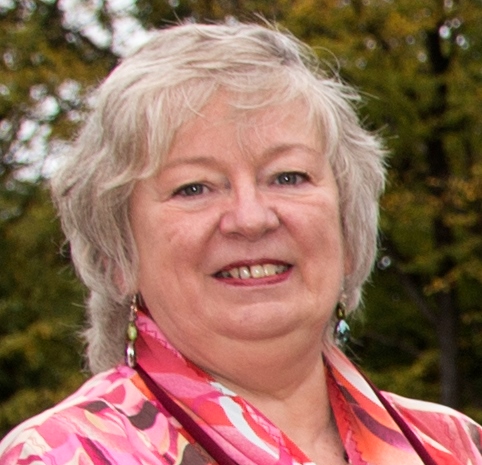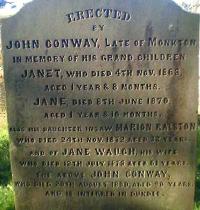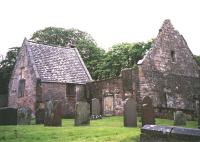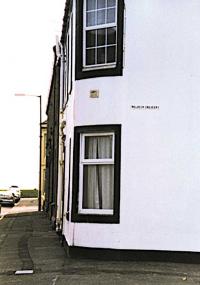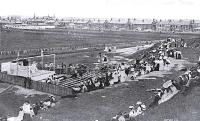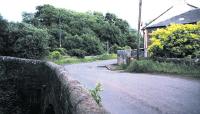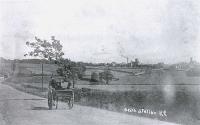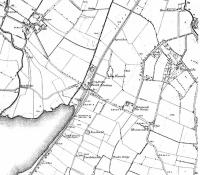- Birth*: Marion Ralstone was born on 12 April 1840 at Tarbolton, Ayrshire, Scotland,
 .1
.1 - She was the daughter of James Ralstone and Janet Murdoch.
- (Bride) Marriage*: Marion Ralstone married Hugh Conway, son of John Conway farm labourer and Jane Waugh, on 9 December 1859 at Tarbolton, Ayrshire, Scotland,
 ; 1854 marriages in the parish of Tarbolton in the county of Ayr, ref 21; On the nineth day of December 1859 at Tarbolton marriage after banns was solemnized between us according to the forms of the Established Church of Scotland; signed Hugh Conway, 24 years residing Monkton, ploughman bachelor, parenst John Conway mason's labourer and Jane Conway ms Waugh; for Marion Ralstone David Ritchie, 20 years, residing Fairfield, domestic servant spinster; parents James Ralston ... labourer and Janet Ralston ms Murdoch; signed David Ritchie minister of Tarbolton, signed John Dunlop witness, signed William Duthie witness; the above marriage was registed by me at Tarbolton on the 12th day of December 1859 Andrew Dunlop registrar.2,3,4
; 1854 marriages in the parish of Tarbolton in the county of Ayr, ref 21; On the nineth day of December 1859 at Tarbolton marriage after banns was solemnized between us according to the forms of the Established Church of Scotland; signed Hugh Conway, 24 years residing Monkton, ploughman bachelor, parenst John Conway mason's labourer and Jane Conway ms Waugh; for Marion Ralstone David Ritchie, 20 years, residing Fairfield, domestic servant spinster; parents James Ralston ... labourer and Janet Ralston ms Murdoch; signed David Ritchie minister of Tarbolton, signed John Dunlop witness, signed William Duthie witness; the above marriage was registed by me at Tarbolton on the 12th day of December 1859 Andrew Dunlop registrar.2,3,4 - (Deceased) Death*: Marion Ralstone died on 24 November 1872 at Railway Station, Beith, Ayrshire, Scotland,
 , at age 32 1872 Deaths in the Parish of Beith in the County of Ayr, # 106; Marion Conway married to Hugh Conway Railway Carter; 1872 November 24th 5h 20m PM Railway Station Beith; Female aged 32 years; Father James Ralstone Agricultural Labourer, Mother Janet Ralstone ms Muirdoch; Diseases of her Liver, Stomach, Bowles and head accompanied with convulsions 2 weeks as certified by Thos Miller CM; Informant Hugh Conway widower present; Registered 1872 November 27th at Beith William Duff Registrar.5
, at age 32 1872 Deaths in the Parish of Beith in the County of Ayr, # 106; Marion Conway married to Hugh Conway Railway Carter; 1872 November 24th 5h 20m PM Railway Station Beith; Female aged 32 years; Father James Ralstone Agricultural Labourer, Mother Janet Ralstone ms Muirdoch; Diseases of her Liver, Stomach, Bowles and head accompanied with convulsions 2 weeks as certified by Thos Miller CM; Informant Hugh Conway widower present; Registered 1872 November 27th at Beith William Duff Registrar.5 - Married Name: As of 9 December 1859, her married name was Conway.
- (Witness) Memorial Inscription: She is commemorated on the headstone erected by John Conway farm labourer circa 1874 at Monkton Churchyard, Monkton, Ayrshire, Scotland,
 . Inscription reads Erected by John Conway, late of Monkton in memory of his grand children Janet, who died 4th Nov 1863 aged 1 year & 8 months, Jane, died 8th June 1870 aged 1 year and 10 months, also his daughter-in-law Marion Ralston who died 24th Nov 1872 aged 32; and of Jane Waugh his wife who died 12th July 1873 aged 61 years; the above John Conway who died 29th August 1890, aged 90 years, and is interred in Dundee.6
. Inscription reads Erected by John Conway, late of Monkton in memory of his grand children Janet, who died 4th Nov 1863 aged 1 year & 8 months, Jane, died 8th June 1870 aged 1 year and 10 months, also his daughter-in-law Marion Ralston who died 24th Nov 1872 aged 32; and of Jane Waugh his wife who died 12th July 1873 aged 61 years; the above John Conway who died 29th August 1890, aged 90 years, and is interred in Dundee.6
- (Bride) Marriage*: Marion Ralstone married Hugh Conway, son of John Conway farm labourer and Jane Waugh, on 9 December 1859 at Tarbolton, Ayrshire, Scotland,
 ; 1854 marriages in the parish of Tarbolton in the county of Ayr, ref 21; On the nineth day of December 1859 at Tarbolton marriage after banns was solemnized between us according to the forms of the Established Church of Scotland; signed Hugh Conway, 24 years residing Monkton, ploughman bachelor, parenst John Conway mason's labourer and Jane Conway ms Waugh; for Marion Ralstone David Ritchie, 20 years, residing Fairfield, domestic servant spinster; parents James Ralston ... labourer and Janet Ralston ms Murdoch; signed David Ritchie minister of Tarbolton, signed John Dunlop witness, signed William Duthie witness; the above marriage was registed by me at Tarbolton on the 12th day of December 1859 Andrew Dunlop registrar.2,3,4
; 1854 marriages in the parish of Tarbolton in the county of Ayr, ref 21; On the nineth day of December 1859 at Tarbolton marriage after banns was solemnized between us according to the forms of the Established Church of Scotland; signed Hugh Conway, 24 years residing Monkton, ploughman bachelor, parenst John Conway mason's labourer and Jane Conway ms Waugh; for Marion Ralstone David Ritchie, 20 years, residing Fairfield, domestic servant spinster; parents James Ralston ... labourer and Janet Ralston ms Murdoch; signed David Ritchie minister of Tarbolton, signed John Dunlop witness, signed William Duthie witness; the above marriage was registed by me at Tarbolton on the 12th day of December 1859 Andrew Dunlop registrar.2,3,4 - Residence: Marion Ralstone and Hugh Conway lived at Glasgow & South Western Railway Station, Beith, Ayrshire, Scotland,
 ; The Glasgow and South Western Railway was a compactly arranged medium sized railway company which served the triangle forming the south-west of Scotland to Carlisle and Stranraer, with its headquarters at Glasgow. It became the third largest in Scotland and was formed by amalgamation of earlier railways in 1850, when the line from Glasgow to Carlisle was completed. The earliest constituent - although it was not formally taken over until 1899 - was the Duke of Portland’s privately financed Kilmarnock and Troon Railway of 1808-1812, built to carry coal from the Duke’s pits near Kilmarnock to Troon Harbour on the Ayrshire coast. This line had several ‘firsts’ for Scotland - the first railway viaduct (which still stands), first fare paying passengers, and first steam locomotive - although it was too heavy for the primitive tramroad track, otherwise horse operated.
; The Glasgow and South Western Railway was a compactly arranged medium sized railway company which served the triangle forming the south-west of Scotland to Carlisle and Stranraer, with its headquarters at Glasgow. It became the third largest in Scotland and was formed by amalgamation of earlier railways in 1850, when the line from Glasgow to Carlisle was completed. The earliest constituent - although it was not formally taken over until 1899 - was the Duke of Portland’s privately financed Kilmarnock and Troon Railway of 1808-1812, built to carry coal from the Duke’s pits near Kilmarnock to Troon Harbour on the Ayrshire coast. This line had several ‘firsts’ for Scotland - the first railway viaduct (which still stands), first fare paying passengers, and first steam locomotive - although it was too heavy for the primitive tramroad track, otherwise horse operated.
Coal was always an important part of the traffic owing to the many collieries in Ayrshire and associated ironworks, steelworks, brickworks and other industries. About 60% of the entire G&SWR wagon fleet were coal wagons, the company having a policy to strictly limit the numbers of private traders’ wagons authorised for use on its lines. In common with other railways the G&SWR carried a wide variety of general merchandise, and more specialised traffic like fish from the Ayrshire ports, boilers and machinery from works in Glasgow/Paisley/Renfrew area.
There was a consolidation of routes with various branches and inter-connecting lines being built up to 1906, two of the last being the coast line from Ayr to Girvan via Turnberry and Dumfries to Moniaive. In 1905 the Kilbirnie loop line was opened, which effectively doubled the capacity of routes from Paisley towards Ayr, as far as Dalry. Under the London, Midland and Scottish regime after 1923 in which the former Caledonian Railway was the dominant partner, the lines and stations saw little change until line closures began to be common after 1930.
Traffic on the Clyde Coast, serving numerous resorts amid outstanding scenery, was a very important aspect of the traffic, as well as minerals and the main line to London. The Glasgow and South Western developed its fleet of passenger steamers on the Firth of Clyde, which had a handsome livery of French grey hull with white topsides and paddle boxes, and deep red funnel with black top. These provided a service including the Isles of Arran, Bute and Cumbrae, and places on the mainland between Greenock and Stranraer, but were not permitted to carry passengers upriver from Greenock nor to sail to Campbeltown or Inveraray. Fast connecting trains serving Greenock Princes Pier, Ardrossan Winton Pier and Fairlie (near Largs) ran to and from Glasgow St Enoch in competition with the Caledonian Railway. However by 1908 this traffic was recognised as insufficient for the intense resources provided by the railway companies and pooling arrangements e.g. on the Ardrossan-Arran run were set up to share the use of steamers. Several steamers served in the First World War; ‘Mars’, ‘Neptune’ and ‘Minerva’ were casualties of this conflict, and never returned.
During the 1930s there was some small reduction in the network by closures of uneconomic routes, but more closures took place in the 1950s and others following the ‘Beeching Report’ or ‘Reshaping of British Railways’ of 1963. This also included a general reduction in goods facilities as more traffic turned to road competition. The last closure was as recently as 1983 being the Paisley Canal line and the remaining part of the Greenock branch, to Kilmacolm. However the tide was turning in favour of railways regarding local authority economic support. The Glasgow/Paisley to Ayr, Ardrossan and Largs lines were electrified by 1986 and part of the Paisley Canal line was re-opened in 1990, followed by re-opening of certain stations on other lines, particularly for commuters.9 - Residence*: Marion Ralstone and Hugh Conway lived at Beith, Ayrshire, Scotland,
 ; The name Beith is thought to derive from Birch, and the whole area was probably once covered with trees. According to the Reverend George Colville, minister in the parish of Beith writing in 1839 for the Statistical Account of the time describes the topographical appearance as slightly undulating throughout, and consequently does not present the varied features of hill and dale … He describes how it had been proposed to build the Ardrossan Canal and that this had been authorised by an act of Parliament in 1805, but having proved far more expensive than had been anticipated, was completed only between Glasgow and Johnstone. In 1825, an act was passed for forming a railway in its stead; but this was not done; and, in 1837, an act was passed for forming a great line of railway through the same valley, from Glasgow by Paisley and Irvine to Ayr, with a branch to Kilmarnock, – which undertaking has recently been commenced. It has been proposed to form a line of railway from Kilmarnock, by Cumnock, Dumfries, and Carlisle, to join the Liverpool railway at Preston, which, if carried into effect, would make this the great line of communication from London to Glasgow and the west coast. Describing the views from the highest point of the parish, Cuff Hill, he says the prospect is unrivalled in the district for extent, variety, and magnificence. To the south and west are visible the mountain ranges of Galloway and Carrick, the spacious estuary of the Clyde, the Craig of Ailsa, and the lift peaks of Arran; while, northward the horizon is bounded by the serrated ridges of Cowal and the wavy outline of the far receding hills of Perthshire, in advance of which, in proud pre-eminence, stand Ben Lomond, the monarch of the scene. The scenery inclosed by so noble a frame-work, especially when its varied features are boldly relieved by the rays of the declining sun, is well calculated to gladden the eye and exhilarate the heart of the spectator.
; The name Beith is thought to derive from Birch, and the whole area was probably once covered with trees. According to the Reverend George Colville, minister in the parish of Beith writing in 1839 for the Statistical Account of the time describes the topographical appearance as slightly undulating throughout, and consequently does not present the varied features of hill and dale … He describes how it had been proposed to build the Ardrossan Canal and that this had been authorised by an act of Parliament in 1805, but having proved far more expensive than had been anticipated, was completed only between Glasgow and Johnstone. In 1825, an act was passed for forming a railway in its stead; but this was not done; and, in 1837, an act was passed for forming a great line of railway through the same valley, from Glasgow by Paisley and Irvine to Ayr, with a branch to Kilmarnock, – which undertaking has recently been commenced. It has been proposed to form a line of railway from Kilmarnock, by Cumnock, Dumfries, and Carlisle, to join the Liverpool railway at Preston, which, if carried into effect, would make this the great line of communication from London to Glasgow and the west coast. Describing the views from the highest point of the parish, Cuff Hill, he says the prospect is unrivalled in the district for extent, variety, and magnificence. To the south and west are visible the mountain ranges of Galloway and Carrick, the spacious estuary of the Clyde, the Craig of Ailsa, and the lift peaks of Arran; while, northward the horizon is bounded by the serrated ridges of Cowal and the wavy outline of the far receding hills of Perthshire, in advance of which, in proud pre-eminence, stand Ben Lomond, the monarch of the scene. The scenery inclosed by so noble a frame-work, especially when its varied features are boldly relieved by the rays of the declining sun, is well calculated to gladden the eye and exhilarate the heart of the spectator.
He describes at length the quarrying of the main local minerals – limestone, and to a lesser extent coal. Turning to the climate and health of the population. The prevailing winds are from the south-west and north-east, which bring heavy rains. The people are on the whole as healthy as in any other parish in the district. He notes that several folk each year reached the age of 95 or over. On the other hand cholera had visited the area twice in recent years, the second in 1834 being most severe.
On the subject of civil history there is detailed description of numerous antiquities and family histories of the Mures of Caldwell, the family of Ralston and Hugh Mongomerie of Braidstane.
Agriculture was a large part of the economy with dairy products prevailing – The cheese is considered equal to the best Dunlop, and bears the highest price as such in Glasgow market. Industry and commerce included thread manufacture, flax spinning, flour milling, tanning and currying leather, bleachfields, and grain merchants. Mr Colville notes that the town is well lighted with gas. Weekly markets were held in the town of Beith on Fridays and numerous trades’ fairs at varying times over the year. Transport was by means of a daily coach from Ardrossan to Glasgow, which passes through Beith in the morning and returns on the evening. Carriers went at various weekly times to Paisley, Glasgow, Kilmarnock, Greenock, Saltcoats and Largs. The post office communications are very advantageous. There are two arrivals and departures daily, and a free delivery of letters twice a-day, and a penny-post daily to the neighbouring towns of Dalry, Kilbirnie and Lochwinnoch. There are four branches of Banks, the Commercial Bank of Scotland, the Glasgow Union, The British Linen Company, and the Paisley Commercial.
Ecclesiastical history (understandably) consumes a large part of the account, but where another writer in another parish extolled the virtues of his new church building, this writer is thrilled with his church bell! The bell in the tower, one of the finest toned in the west country, was the gift of Robert Shedden Esq, Gower Street, London, a native of the parish …
It is noted that there has been schooling available form some long time, records revealing that a schoolmaster was in post in 1644. The schools in the town, of which there were six, including the parish school, were responsible for the education of five hundred youngsters being nearly the tenth part of the population. Mr Colville also praises the work of the Sabbath evening schools of the time – … Mr Reid, with the assistance of two or three benevolent individuals, teaches gratuitously a school two evenings a week, which is of great benefit to a numerous portion of the poorer children, whose necessary employment prevents them from attending the day school.
There is some discussion of benevolent societies instituted for affording relief to aged and indigent members, but these seem to have ceased through lack of funding.
In conclusion, Mr Colville observes that since the last Statistical Account was written (in 1791), very considerable improvements have taken place in this parish. The roads, both turnpike and parochial, are in better order … the houses of the wealthier inhabitants are … more commodious and comfortable, but many of the weavers and labourers, and even the farmers, are meanly lodged. … All sorts of cloths, groceries, and butcher-meat can be got here as goods as in Glasgow … That the morals of the people are improved in proportion to their means and opportunity, it would perhaps be reckless to assert. Certainly there is no longer that reckless daring of the law which was characteristic of the place when it was a seat of smuggling; yet offences are too frequent, which are generally the results of excessive drinking … There has always been a due share of valour and patriotism in this place. At the Revolution, a company of volunteers was raised in defence of the King and constitution … During the war with Buonaparte, the Beith volunteers and local militia were always prompt and respectable; and individuals belonging to the place have fought with Abercrombie in Egypt, with Nelson at Trafalgar, and with Wellington at Waterloo.10 - [S1] International Genealogical Index (IGI) (Salt Lake City, Utah, USA: International Genealogical Index), C116195.
- [S1] International Genealogical Index (IGI), 7011809.
- [S1] International Genealogical Index (IGI), M116191.
- [S64] General Record Office for Scotland, online www.scotlandspeople.gov.uk, General Record Office for Scotland (Edinburgh, Scotland), GROS statutory marriages 1859 Tarbolton ref 21 image held [Jul 2004].
- [S50] General Record Office for Scotland, online www.scotlandspeople.gov.uk, General Record Office for Scotland (Edinburgh, Scotland), 1872 Beith # 106 [Jun 2004].
- [S21] Headstone Photograph; , Kenny Monaghan [Jan 2007].
- [S17] General Record Office for Scotland, online www.scotlandspeople.gov.uk, General Record Office for Scotland (Edinburgh, Scotland), GROS census 1861 [Jun 2004] Parish of Dundonald, Village of Troon 11 Welbeck Crescent.
- [S17] General Record Office for Scotland, Civil Parish of Beith; G&SW Railway Station, image held [Jun 2004].
- [S49] Website Web Site online (www.) from A Short History of the Glasgow & South Western Railway (pub The Glasgow & South Western Railway Association) http://www.gswrr.co.uk/
- [S49] Website Web Site online (www.) http://stat-acc-scot.edina.ac.uk/sas/sas.asp/?monospace=&twoup=&nohighlight=&account=2&transcript=&session-id=0eb5a1951110fc447daf8f49002ce21f&naecache=8&accountrec=4436&navbar=&action=publicdisplay&parish=Beith&county=Ayrshire&pagesize=
Marion Ralstone
F, #538, b. 12 April 1840, d. 24 November 1872
Last Edited: 7 Aug 2022
Parents:
Family:
Hugh Conway b. 1836, d. 16 Mar 1919
Children:
Janet Conway b. 22 Mar 1862, d. 4 Nov 1863
John Conway b. 28 Feb 1864
Janet Meney Conway b. 17 May 1866
Jane Conway b. 28 Jul 1868, d. 8 Jun 1870
Jane Conway+ b. 27 Dec 1870, d. 5 Feb 1948
John Conway b. 28 Feb 1864
Janet Meney Conway b. 17 May 1866
Jane Conway b. 28 Jul 1868, d. 8 Jun 1870
Jane Conway+ b. 27 Dec 1870, d. 5 Feb 1948
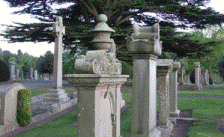 Genes on the Web
Genes on the Web